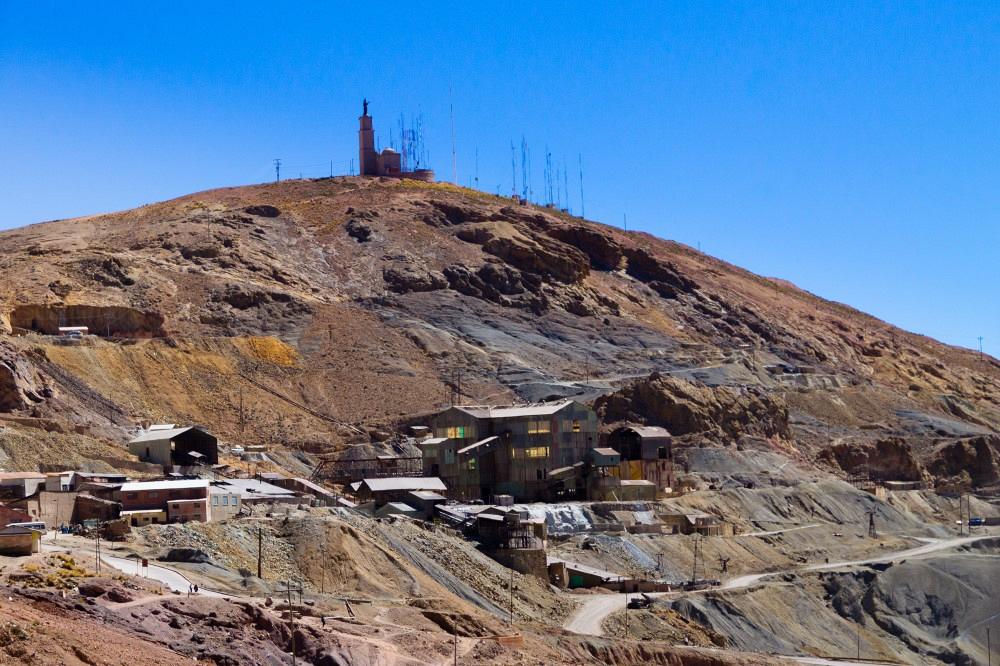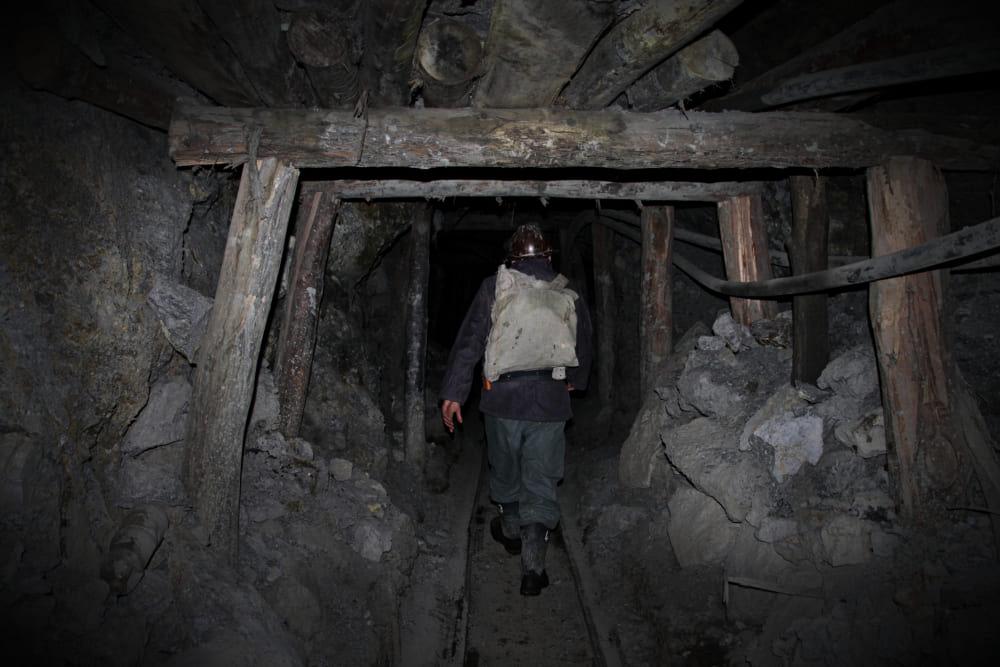Owner, Brown Dog Welding
- FMA
- The Fabricator
- FABTECH
- Canadian Metalworking
Categories
- Additive Manufacturing
- Aluminum Welding
- Arc Welding
- Assembly and Joining
- Automation and Robotics
- Bending and Forming
- Consumables
- Cutting and Weld Prep
- Electric Vehicles
- En Español
- Finishing
- Hydroforming
- Laser Cutting
- Laser Welding
- Machining
- Manufacturing Software
- Materials Handling
- Metals/Materials
- Oxyfuel Cutting
- Plasma Cutting
- Power Tools
- Punching and Other Holemaking
- Roll Forming
- Safety
- Sawing
- Shearing
- Shop Management
- Testing and Measuring
- Tube and Pipe Fabrication
- Tube and Pipe Production
- Waterjet Cutting
Industry Directory
Webcasts
Podcasts
FAB 40
Advertise
Subscribe
Account Login
Search
Appreciation for the miners of Cerro Rico
A closer look at the dangers of mining for metals in a Bolivia mountain called “The Mountain that Eats Men”
- By Josh Welton
- November 21, 2020
“Outside the mine, we’re Catholics. Inside we worship the devil.”
Cerro Rico (aka Sumaq Urqu; aka Rich Mountain; aka The Mountain that Eats Men) is a 15,800-ft.-high mountain in Bolivia once rich with elements like lead, zinc, and especially silver. It’s been mined for 450 years, early on by locals enslaved by Incas; then by those same locals and same Incas enslaved by the Spanish Empire; and then eventually by tens of thousands of imported slaves, who all made their Spanish overlords rich through brutal extraction labor.
Now it is dug by local folks who aren’t treated much better by their “collective” bosses. Cerro Rico is the largest source of silver in human history, traded for the more than 8 million souls lost in this Bolivian mountain of the Andes. A passage from Uruguayan journalist Eduardo Galeano’s book Open Veins of Latin America sums it up:
“You could build a silver bridge from Potosí to Madrid from what was mined here - and one back with the bones of those that died taking it out."
And while the easy pickins are gone, there’s plenty left to blast free and collect.
In the U.S. we do a pretty decent job of maintaining safe working conditions, and there’s no better contrast to us than what these miners deal with daily. One documentary-style short film that I can’t recommend highly enough is called “Cerro Rico: The Silver Mountain.”
It follows a small group of miners as they go about their daily routine: Wake up and get dressed, walk to the bus, grab a bag of green coca leaves on the way, ride the bus up to the mine entrance, find PPE in a dirty pile of junk, flip a heavy metal trolley cart onto the tracks, then descend into the abyss.
This intro does an excellent job of giving context to the workers’ lives. They are poor and there’s nothing else to do in Potosí to put food on their tables. There’s a father who wants to give his family a better life and his son who wants to take the pressure off his aging dad. Then there’s the young married man, who is a newly minted father himself, needing to provide for his family as well. While not featured in this doc, children are often in the mountain too. Another movie, “The Devil’s Miner,” follows a 14-year-old and his brother as they work the mines.
The conditions are insane. Picture a mineshaft, but as a hole that a muskrat would dig, not a person. There’s a narrow steel track for the trolley bucket to roll on, but it’s broken in places so it must be manhandled to make the full trek. The miners jump into an ominous labyrinth from the cart’s resting place that goes side to side and up and down. They twist and contort through tiny openings like a cat does when it finds a little spot in the fence line to squirt through. Trigger Warning: If you’re claustrophobic, sit this one out.
Some parts of the tunnel system have no reinforcement, but even the places where it does don’t lend themselves to confidence as there are too many broken boards and partially collapsed walls for my liking. Then there’s that within the last decade, some concerned folks have been warning that the mountain – with tens of thousands of tunnels in it – is in real danger of imploding.
A hammer drill is plunged into the rock shortly after their “journey to the center of the earth” ends. The workers don masks, but the filters look like they’re older than the men wearing them. The dust from the drill is bad, yet it pales to what’s yet to come. Sticks of dynamite, which the miners pack themselves, are placed into a pocket created by the drill. The fuses are lit and the workers scramble to a “safe” distance. They hunker down and break out the coca leaves and ilucta.

Cerro Rico (aka Sumaq Urqu; aka Rich Mountain; aka The Mountain that Eats Men) is a 15,800-ft.-high mountain in Bolivia once rich with elements like lead, zinc, and especially silver. Getty Images
My ignorant ass thought this one dude had a tumor. It turns out he just had a big ball of coca in his cheek all the time. Combined with ilucta, it acts as a stimulant and is thought by many to carry medicinal benefits. The indigenous workers get through their day with a little help from one of cocaine’s building blocks.
Well, that and a bit of alcohol. You can hardly blame them. The job is basically a terminal illness. The life expectancy of a Cerro Rico miner is less than 40 years. Out of about 15,000 workers, one person a day is killed in the mountain. Health care, OSHA, labor rights, child labor laws - these concepts are foreign or meaningless to them. You squeeze through those tiny undulating tunnels to plant explosives in a “Swiss cheese“ mountain ready to collapse under its own weight and tell me you couldn’t use a shot of whiskey.
“We’re just happy!” That’s a statement I wasn’t expecting to hear. Yet here are these natives of the region telling the camera that their co-workers are like family when they go underground, and they love what they do. Plus, they are protected by the Devil, and they’ve built shrines to him in the mountains, although with the death stats, I’m not sure he’s actually paying attention.
As a bag of coca leaves is passed around, and the lumps in their cheeks get fatter, they hear the first explosion. “One!” They need to make sure each explosive is accounted for before heading toward the event location, “Two!” All the way to “10!” Clouds of post-blast debris float to them. Then, with the threat of dynamite suppressed, the miners head back through the mist to collect their bounty, chatting about how maybe they’d find a new vein of silver and their “co-op” masters will give them a bonus. They fight through the heavy, dirty, stagnant air to load up the trolley and push/pull it up some inclines and ride it down the declines, before finally bursting back into daylight.
The miners try to shake off the dust from themselves and their PPE. Then they’ll do it again tomorrow. And the next day. And the next. Until their breath is no more.
subscribe now

The Fabricator is North America's leading magazine for the metal forming and fabricating industry. The magazine delivers the news, technical articles, and case histories that enable fabricators to do their jobs more efficiently. The Fabricator has served the industry since 1970.
start your free subscriptionAbout the Author

- Stay connected from anywhere

Easily access valuable industry resources now with full access to the digital edition of The Fabricator.

Easily access valuable industry resources now with full access to the digital edition of The Welder.

Easily access valuable industry resources now with full access to the digital edition of The Tube and Pipe Journal.
- Podcasting
- Podcast:
- The Fabricator Podcast
- Published:
- 04/16/2024
- Running Time:
- 63:29
In this episode of The Fabricator Podcast, Caleb Chamberlain, co-founder and CEO of OSH Cut, discusses his company’s...
- Trending Articles
How to set a press brake backgauge manually

Capturing, recording equipment inspection data for FMEA

Tips for creating sheet metal tubes with perforations

Are two heads better than one in fiber laser cutting?

Hypertherm Associates implements Rapyuta Robotics AMRs in warehouse

- Industry Events
16th Annual Safety Conference
- April 30 - May 1, 2024
- Elgin,
Pipe and Tube Conference
- May 21 - 22, 2024
- Omaha, NE
World-Class Roll Forming Workshop
- June 5 - 6, 2024
- Louisville, KY
Advanced Laser Application Workshop
- June 25 - 27, 2024
- Novi, MI



























